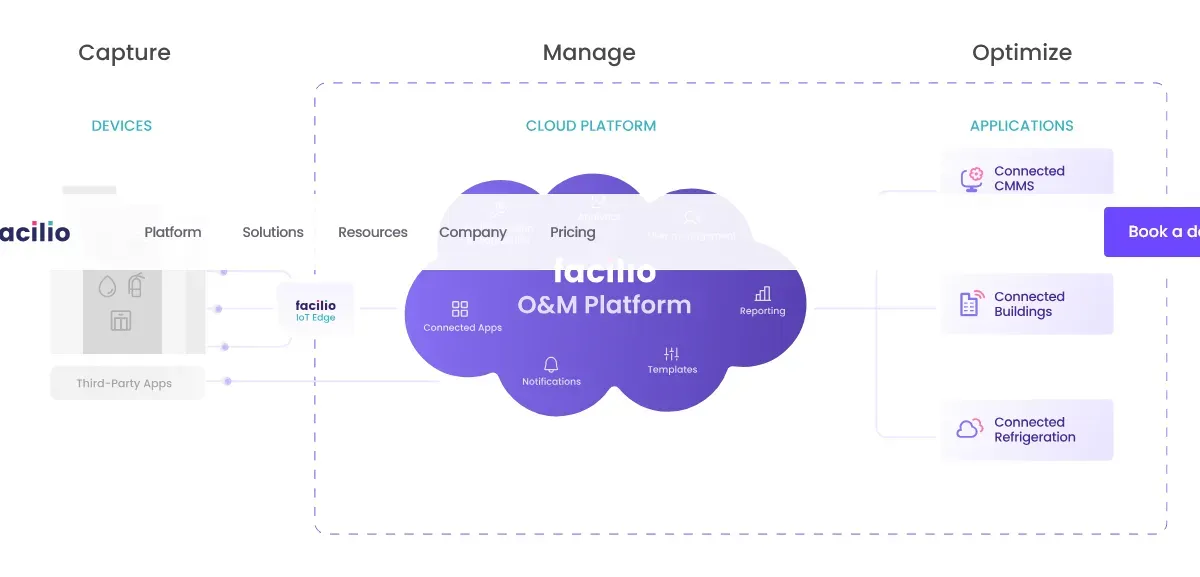Building Operations & Maintenance
From Chaos To Control: How Facilio’ Unified Helpdesk Can Streamline Facility Management
If your helpdesk and CaFM systems aren't talking to each other, it's like trying to have a conversation with someone who's wearing noise-canceling headphones.
You're shouting, they're oblivious, and everyone's frustrated.
Between juggling multiple clients, tight SLAs, and demanding stakeholders, this kind of communication breakdown is a recipe for disaster. It leads to delays, miscommunication, and a whole lot of unnecessary stress.
The helpdesk isn't just a call center, it's the frontline of client interaction, the pulse of your operations. It's where tenant satisfaction is won or lost.
A seamless helpdesk experience ensures swift issue resolution, proactive communication, and ultimately, happy clients who keep coming back for more.
What is a facilities management helpdesk?
Why your helpdesk and CaFM should be best mates
What if your helpdesk and CaFM could actually have a meaningful conversation?
What if every service request triggered coordinated action, with everyone on the same page, from the client to the technician?
The moment a tenant raises an issue,
- Your team has instant access to the full asset history, maintenance schedules, and even real-time sensor data.
- Work orders are automatically generated, assigned to the right technician, and tracked in real-time.
- Clients receive proactive updates, keeping them informed and reassured.
- Data-driven insights help you identify trends, optimize preventive maintenance, and make smarter decisions.
That is the power of a truly connected ecosystem built for all stakeholders - a property operations platform.
When your helpdesk and CaFM are seamlessly integrated, they stop being isolated islands of information and start working as a unified team.
Suddenly, you have real-time visibility into every asset, every issue, and every step of the resolution process. Fortunately, this pipe dream is what Facilio built out.
It's about more than just connecting the dots.
We're not just talking about slapping a band-aid on the problem. Facilio's platform is designed from the ground up to create a connected ecosystem where information flows freely, collaboration is effortless, and data-driven decisions become second nature.
For FMSPs, this translates to:
- Winning more contracts: Demonstrate your commitment to innovation and efficiency with a truly modern approach to service delivery.
- Delighting clients: Respond faster, resolve issues proactively, and provide transparent communication every step of the way.
- Boosting profitability: Streamline operations, optimize resource allocation, and reduce unnecessary costs.
For facility managers who are still relying on manual or outdated systems, managing maintenance requests can often feel like navigating a never-ending trail of paperwork, time-consuming manual processes, and resultant delays.
Over a period of time, when the number of assets and facilities to oversee grows, facility managers struggle to keep up with the volume and variety of service requests. Inevitably, this increases response times and causes operational inefficiencies to nosedive while compromising occupant comfort, safety, and satisfaction.
Outdated and fragmented helpdesk management systems are undoubtedly the root cause of these challenges. They are the primary culprits behind a wide range of facility management issues like improper asset management, broken stakeholder communication, and a lack of real-time visibility.
In a world where real-time is the norm, traditional fragmented systems are akin to snail mail.
Facility management cannot be stuck in the legacy era forever. It has to embrace digitization as the path forward. An immediate transition to a connected and centralized platform that can streamline helpdesk operations, automate workflows, and provide real-time insights is necessary.
Such a centralized approach will empower the facility managers and maintenance teams to resolve hard and soft maintenance requests faster, and develop a more proactive rather than a reactive facility maintenance strategy.
Digitization is the way forward for facilities management and investing in a facilities management helpdesk is the first step facilities managers can take in that direction.
Here is a short primer on what to expect from a facilities management helpdesk.
Based on their role and approach facility helpdesk teams can be classified into two categories each with two types:
- Based on resources
Resources imply actual workforce, on-the-field employees who handle service requests and resolve them with their training and expertise.- Desk side team
- Specialized teams
- Based on software
Software refers to on-premise or cloud-based software that employees use to create, manage, and report on facilities management operations.- Helpdesk software
- Modern computer-aided facility management (CaFM)) software
The need for facilities helpdesk software in facilities management
Every large-scale facility inevitably needs a facilities help desk software to streamline operations. Here is how it can help:
24/7/365 support availability
Facilities helpdesk software offers round-the-clock service, ensuring that maintenance requests are logged and addressed irrespective of the time of day.
This “always-on coverage” ensures that critical issues are prioritized and addressed promptly, which ultimately reduces equipment downtime and prevents potential disruptions.
Maximizes occupant safety and comfort
With automated workflows, the software ensures that occupant safety protocols and comfort standards are always prioritized. It ensures that service requests related to safety are addressed first, while other medium and low-priority tasks are handled promptly but secondary to safety concerns.
For example, issues like gas leaks, fire outbreaks, suspended lifts, etc., are labeled and prioritized for immediate resolution. This helps in maintaining a secure and comfortable environment for tenants and employees.
Handles cascading issues efficiently
Secondary incidents, such as malfunctioning lights or burst water pipes, arise unexpectedly and create additional strain on facilities management. While these issues may not pose an immediate threat to health and safety, they still require prompt attention to prevent escalation.
Facilities management software helps prioritize these incidents based on their severity, whether they affect security, building integrity, or health.
Enhances stakeholder communication
By streamlining communication and providing real-time updates, facilities helpdesk software ensures more inclusive stakeholder communication.
It helps ensure that every request is tracked, followed up on, and resolved in a timely manner, which improves overall satisfaction.
The Domino Effect: When your Helpdesk is out of sync
Now, imagine trying to deliver top-notch service with a clunky, disconnected helpdesk.
- Operational Chaos: Technicians are chasing their tails, managers are drowning in spreadsheets, and response times are through the roof. It's a recipe for burnout and missed SLAs.
- Financial Drain: Delays, rework, and penalties eat into your profits faster than you can say "service charge dispute."
- Client Exodus: Unhappy clients don't stick around. They'll find an FMSP who can deliver on their promises.
- Team Morale Nosedive: When your team is constantly battling outdated systems and frustrated clients, it's no wonder morale takes a hit.
The lack of a unified helpdesk will hurt a business both in the short and long-term. From straining resources to eroding client relationships, it will place the facility as one that is disorganized and inefficiently managed.
The detrimental impact operational efficiency
A fragmented helpdesk system is bound to cause operational bottlenecks that make it almost impossible to respond to requests in real-time. Further, these inefficiencies often cascade into other areas, disrupting workflows and increasing costs.
- Siloed information: When data lives in separate systems, connecting the dots to form a big picture of operations is difficult. This slows down decision-making and delays resolutions, ultimately affecting response times and operational efficiency.
- Duplicated efforts: A lack of automation often leads to teams repeating tasks that could be streamlined. Not only does this waste time and resources, but it also increases the risk of avoidable mistakes.
- Poor resource allocation: Without clear data on where problems are cropping up, you’re left guessing how to staff your team. Overstaffing wastes budget, while understaffing creates service delays that frustrate customers and teams alike.
The detrimental impact on financial performance
A lack of a unified helpdesk doesn’t just impact day-to-day operations — they’re a drain on your finances as well. Inefficient processes drive up costs, while poor customer service leads to lost revenue and increased churn.
- Increased costs: Relying on manual processes and not having full visibility of building operations can drive up operational costs, even for things that could be streamlined.
- Revenue loss: Dissatisfied customers are more likely to churn and move to competitors for better services, resulting in significant revenue leakage that can erode profitability.
- Compliance risks: Fragmented systems make it difficult to automate reporting or consistently track compliance requirements, causing compliance risks. Non-compliance can lead to costly fines and legal complications.
The detrimental impact on client relationships
When your helpdesk isn’t running smoothly, it creates operational chaos, ultimately creating a negative client perception. Trust starts to erode, and that can have serious long-term consequences.
- Eroded trust: When issues aren't resolved quickly and efficiently, clients perceive a lack of accountability and care, causing trust in your services to dwindle. They start questioning whether they can count on your company to deliver, which is a tough spot to recover from.
- Negative brand perception: Poor communication and inefficient issue resolution damage the company’s image, hurting customer satisfaction.
- Increased customer churn: When clients repeatedly face unresolved issues, their frustration drives them to explore alternatives, ultimately leading to increased churn and loss of valuable business. It is always harder to win new customers than to retain existing ones.
The detrimental impact on employee morale
When employees are forced to work with inefficient systems, everyday work routine becomes taxing, hurting their work morale. Such an environment fosters stress and dissatisfaction, which can lead to higher attrition rates.
- Increased stress: Juggling multiple tools and working on time-consuming paper trials and fragmented systems creates unnecessary stress, overwhelming employees and impacting their ability to perform effectively.
- Decreased job satisfaction: Without a unified system that allows for clear tracking and resolution of service requests, employees can feel unsupported and undervalued, leading to disengagement.
- Higher turnover: Chronic stress and dissatisfaction contribute to higher levels of employee turnover, which can create additional costs and disrupt the workflow even further.
Given the significant impact of a fragmented helpdesk, it's clear that optimizing your helpdesk is not just a smart move — but a necessary move.
Let's see how you can streamline your facilities help desk for maximum effectiveness.
How to optimize your facilities helpdesk for maximum efficiency
A facilities help desk is only a starting point to streamline operations and maintenance. There is still room for optimization that can uplift stakeholder satisfaction and improve operational efficiency.
Gather service requests through a dedicated employee mobile app
In facilities management, the usual practice is to write to the dedicated email of the maintenance team to create a ticket. However, a better approach would be to allow employees to log in service requests through a dedicated mobile app.
The mobile app can give more flexibility in ticket creation and provide real-time notifications for stakeholder communication.
Integrate your helpdesk with an integrated workplace management system (IWMS)
An IWMS is a centralized hub where all facility management data is collected and managed. Integrating the helpdesk with an IWMS can optimize resource allocation, and streamline workflows.
This integration enables more effective tracking of service orders, asset management, and preventive maintenance, improving overall operational efficiency.
Invest in a cloud-based CaFM software
Upgrading to a cloud-based CaFM software can be a game-changer for facilities that are excessively reliant on fragmented systems. It unifies all facility operations and also provides the right planned maintenance system that can minimize unplanned downtime.
A CaFM can arm facility managers with the data insights needed to identify potential issues before they occur, which prevents unplanned downtime and the associated operational expenses .
Automate task prioritization and escalation
Manual task prioritization is riddled with inefficiencies. It will cause unnecessary wastage of resources and also delay response times. Using the helpdesk software to automatically prioritize tasks based on urgency, location, and resource availability is the better alternative.
Leverage IoT and smart sensors for real-time monitoring
Facility management requires monitoring far-located equipment in real-time performance. For a facility manager overseeing a portfolio of facilities, this is next to impossible.
Leveraging IoT devices and smart sensors within your facility's infrastructure can make real-time monitoring possible. IoT sensors can be easily attached to equipment to monitor air quality, temperature, and several other parameters.
These sensors can alert the helpdesk in real time when the equipment breaches set thresholds, allowing for quicker response times and proactive maintenance.
Case study: How Facilio’s connected CaFM streamlined portfolio-wide retail ops
Georgia-based Tuten Labs was able to reduce its customer service calls by 10-15% and improve response times with intelligent alarm management. Facilio’s connected CaFM also unified its portfolio-wide maintenance operations.
About Tuten labs: They help retail stores reduce energy consumption, emissions, and costs while ensuring a consistent in-store experience.
Tuten Labs lacked a centralized remote monitoring system which created countless operational challenges like:
- Alarm fatigue & slow response times
- Manual alarm reconciliation
- Manual work order processing
With Facilio, it was able to overcome these challenges and streamline its portfolio-wide retail ops.

Proactive facilities maintenance with Facilio: The unified CaFM Helpdesk
Facilio is a connected CaFM software that simplifies facility management across the portfolio. It leverages IoT to pull real-time data that helps facility managers to manage assets, workforce, and compliance in one place.
Here is how it helps:
Digitization of end-to-end service management
Facilio's unified CaFM help desk provides complete digitization of service management, covering all types of maintenance, including hard, soft, planned, and reactive.
It offers a centralized help desk portal and automated service level agreement (SLA) tracking, which reduces manual work for facilities managers.
Centralized help desk portal: Facilio offers a dedicated portal for submitting, viewing, and managing service requests from tenants and guests across locations.
This centralization streamlines communication and ensures all service requests are handled in a standardized and efficient manner.

Automated SLA tracking and escalations: Facilities managers can easily monitor SLA compliance across all vendors who serve their portfolio.
Facilio also automates escalations and notifications, ensuring that SLAs are met without the need for constant manual oversight.

Improved stakeholder communication and reporting
Stakeholder communication and visibility are two inevitable aspects of facilities management. Facility management service providers (FMSPs) earn their stakeholders’ trust through real-time communication of operations and timely reporting.
However, such reporting is easier said than done, when manual processes are involved. FMSPs typically need to deliver monthly reports on their operations. With legacy CaFM systems, this task could take hours of manual effort at the end of each month.
Facilio's automated reporting tools generate real-time reports for every client, drastically reducing the time and effort required by helpdesk members to create these reports.
Unified portfolio operations
Facilio's connected CaFM solution unifies all aspects of property management and portfolio operations, ensuring seamless integration across various facility management functions.
It follows the Capture ➡ Manage ➡ Optimize flow of operations which is bound to improve efficiencies across the organization.

These include:
- Facility maintenance and inspections: Ensures that routine and preventive maintenance tasks are tracked and completed efficiently from a centralized system
- Inventory and asset management: Centralizes the management of assets and inventory, improving ease of locating equipment for maintenance
- Energy and asset performance optimization: Uses real-time data to optimize energy use and improve overall asset performance
- Tenant servicing: Provides real-time communication of service requests and delivery to tenants
- Vendor management: Manages external contractors, ensuring SLA compliance and timely service delivery
- Compliance management: Keeps a log of all regulatory compliance and also auto-creates reports for compliance
From streamlining granular task management to offering real-time, portfolio-wide oversight, effective help desk management is a game-changer for facilities maintenance.
By centralizing service requests, it improves response times, and enhances stakeholder experiences. This can significantly boost your facility’s overall performance as well.
And this is just the beginning — Facilio offers advanced tools to transform how you manage your facilities. Want to see the full scope of what Facilio can do?
There is much more that Facilio can do to transform your facility management.
Frequently asked questions (FAQs)
How do facilities managers typically track and manage service level agreements (SLAs) across different facilities?
In the past, facilities managers used legacy systems and manual processes to track SLAs. Today, they are being replaced with facilities management software that centralizes all service requests and performance metrics in one platform.
Such a platform-based approach enables facility managers to monitor the timeliness and quality of service delivery across various facilities while ensuring compliance with predefined SLAs.
How does a centralized help desk improve operations for facilities management service providers (FMSPs)?
A centralized help desk streamlines operations by consolidating all service requests, communications, and maintenance records into a single platform.
This consolidation eliminates inefficiencies that multiple tracking systems and manual processes often create. It also improves coordination between teams, leading to faster resolution times, better resource allocation, and improved service delivery across all facilities.
How can facilities help desk software streamline the handling of maintenance requests and reduce response times?
Facilities helpdesk software allows users to submit maintenance requests digitally, which are automatically logged, prioritized, and assigned to the appropriate technician.
With real-time updates and notifications, the software ensures requests are attended to swiftly, minimizing delays in response times. Additionally, automated workflows reduce manual intervention and increase operational efficiency.
What features are considered essential in a helpdesk management system to effectively support facility management tasks?
The essential feature list can vary based on industry and business context. However, generally, the essential features include:
- Automated ticketing and task assignment
- Real-time tracking of work orders
- Third-party integrations(such as building automation system, IWMS or CaFM)
- Data analytics and reporting
Other must-haves include mobile accessibility, customizable workflows, and the ability to prioritize tasks based on urgency and impact on operations.

